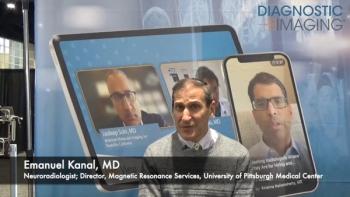
CT’s Top 5 for 2020
Thanks to COVID-19, CT was largely in the spotlight this year, but these Top 5 stories show advancements for the modality in other areas, as well.
CT has been at the center of discussions in radiology this year as the primary imaging modality used with patients suspected of COVID-19 infection. But, a great deal more happened during the past 12 months with this scanning method. Research revealed to the industry that CT can play a role in predicting heart attacks, as well as Alzheimer’s. There were also several efforts this year designed to further drive down radiation dose exposure when patients undergo these scans.
In particular, the Diagnostic Imaging audience gravitated the five CT articles the most this year. Take a look at the synopses below for a quick reminder.
Date Published: Aug. 18, 2020
Coronary artery calcium (CAC) scores, gleaned from a cardiac CT scan, can better tell a provider if a patient will have a heart attack rather than a stroke in the next 10 years. In fact, with a CAC score at or over 100, patients – black, white, and Hispanic men and women – have a two-fold greater risk of a heart attack, said University of Texas Southwestern Medical Center researchers in Circulation: Cardiovascular Imaging. When risk factors, such as smoking or high blood pressure, are not clear cut, providers can use a CAC score to decide on a statin prescription.
Take-Away Message: Providers can use CAC scores to determine how aggressively to treat patients who have never had a major cardiac event but who have additional risk factors, such as high blood pressure or high cholesterol.
Date Published: July 23, 2020
Splitting a full X-ray beam into beamlets can reduce the radiation dose without affecting image quality. University College of London researchers shared their work in Physical Review Applied after testing the technique in a micro CT scanner. An X-ray broken into beamlets and moved in a cylindrical motion is comparable to a conventional CT, they said. Using the technique at the same dose as a CT scan can actually increase image clarity.
Take-Away Message: Researchers intend to move this technique into medical imaging to reduce patient exposure.
Date Published: July 10, 2020
COVID-19 pneumonia presents differently from pneumonia caused by the influenza virus. According to research published in the American Journal of Roentgenology, investigators from China determined that COVID-19 lesions are more apt to appear in the peripheral zone close to the pleura. But, lesions from influenza virus pneumonia are more likely to show mucoid impaction and pleural effusion. Other features of the lesions are largely similar across between COVID-19 and influenza virus pneumonia.
Take-Away Message: CT images are not sufficient alone for distinguishing between pneumonia caused by both viruses. The images must be paired with clinical indications
Date Published: Aug. 7, 2020
The more a patient weighs, the more likely he or she is to have higher levels of brain dysfunction, according to CT scans. Individuals who are overweight or obese have greater risks for Alzheimer’s and other forms of cognitive decline. Based on work conducted by Amen Clinics published in the Journal of Alzheimer’s Disease, blood flow to the brain – the No. 1 brain imaging predictor of Alzheimer’s -- progressively decreased as weight increased. The results bolster the growing perception that Alzheimer’s is a lifestyle disease.
Take-Away Message: With 72 percent of Americans being categorized as overweight or obese, this finding could have far-reaching implications for encouraging weight loss and management.
Date Published: July 29, 2020
Controlling radiation dose in pediatric patients has been a focus in radiology for many years. This year, a multi-institutional team compiled a Top 10 list in the American Journal of Roentgenology of tips to help providers keep dose to a minimum while capturing quality images. They advise radiologists to know their patient and their scanner, to pay attention to the timing of scans, to educate themselves about IV access and contrast agent risks, to pay attention to kilo-voltage settings and scan direction, as well as several other recommendations.
Take-Away Message: These CTA principles should be strictly followed in order to optimize the scan and protect patients as much as possible.
Newsletter
Stay at the forefront of radiology with the Diagnostic Imaging newsletter, delivering the latest news, clinical insights, and imaging advancements for today’s radiologists.




























